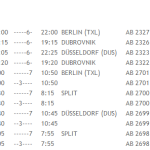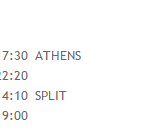The most famous figures in Split-Dalmatia County gathered to discuss sustainable tourism development in cities with a historic core on Tuesday in Split.
On Tuesday, the conference titled “Sustainable tourism development in cities with a historic core” was organized by Slobodna Dalmacija at the Radisson Blu Resort, reports Slobodna Dalmacija on October 23, 2018.
“The development of sustainable tourism in cities with a historic core has long agitated the people of Šibenik, Trogir, Split, Korčula, and Dubrovnik. In most of these cities, we are present not only with our daily newsletter but also with local releases of Slobodna Dalmacija. I am therefore grateful that in Šibenik, Split and Dubrovnik, Croatia’s tourist community and the Tourist Association SDI and ACI have come to a great understanding and assistance in organizing this conference. This topic is not political, it is above all vital and, because of our connection with the historical heritage, and emotions, we need a lot of professional knowledge and goodwill to make the development of tourism in our regions sustainable. We have the best interlocutors and so I, like you, are happy to listen to them and I’m confident that it will be useful,” said Jadran Kapor, the editor-in-chief of Slobodna Dalmacija, in an introductory presentation at the conference.
The importance of this meeting of experts was supported by the Split Mayor Andro Krstulović Opara, who thanked Slobodna Dalmacija for recognizing this important topic.
“The complex we are facing does not have a unique recipe for a solution, therefore it should be sought with competent interlocutors – by who and at which point is a decision made to prevent breaking the branch we’re sitting on? If growth is 16 percent, does the budget increase so much? No. Who then suffers? Citizens. Are tourist institutions returning this income to the city? I do not think so. I would like the discussion to be in view of the broader picture. In 10 years we came from 4,000 with 35,000 legal beds in Split. Today, we have an empty historic core because the life we had there is no longer there. In a couple of years tourists will not come to look at empty stories, but authenticity. The historic core is not made up administrative decisions, but the way of life, the cats, and the clotheslines. Sustainable tourism is a wider problem both of the Mediterranean and Europe,” said the mayor of Split, who added that the same “recipe” cannot be valid for all cities, that is, there is no universal solution.
Blaženko Boban, Split-Dalmatia County Prefect, thanked the organizer of the conference for discussing an extremely important topic that depends on the strongest branch of the economy in the country.
“Many countries in the world have the sun, sea, and gastronomy, but security is a segment that sets us apart from others, and there is also our segment of cultural heritage. In Croatia, the Association of Historic Cities was formed, highlighting the issues we are talking about today and which Slobodna Dalmacija has recognized with the panel discussion. The crucial segment to be discussed is citizen awareness. Fortunately, or unfortunately, tourism is our strongest economic branch, and it encloses a security segment – where would the Croatian economy be? That is why it is important to talk about sustainable tourism and to think wider than the historic core,” concluded the Split-Dalmatia County Prefect.
Frano Matušić, State Secretary of the Ministry of Tourism, reminded of the new Law on Tourism Communities which foresees establishing destination management, thus encompassing the synergy of all stakeholders in tourism.
“The key is in developing quality tourist offers in the destination, which all stakeholders should think about, from caterers to agencies, tourist board directors to the mayor, and so on. These are the questions that will be dealt with in the next decade. Would the historic core be attractive if there was no tourism? Who would it be attractive to? Tourism has some challenges, but above all it is a chance for small businesses to discover. Realistically, Croatia has a lot of challenges to deal with and we do it with the help of EU funds. Everything we do in the Ministry is linked to sustainable development,” Matušić said, adding that managing the destination is of the utmost importance.
“If, for example, Split and Dubrovnik cannot accommodate 15,000 to 20,000 guests in two hours, then it should be considered whether this can be done by the wider city area. The key is in a quality tourist product in the destination. We now have a large number of private accommodations in Split, which is because of the lack of hotels. We are not against private accommodation, we just want to improve it further through recategorization. It strengthens house budgets, but does not bring new jobs such as, for example, a five-star hotel that is open all year long,” Matušić pointed out.
The panel discussion following the introductory speeches was attended by Mato Franković, Mayor of Dubrovnik, Split Mayor Andro Krstulović Opara, Joško Stella, Director of the Tourist Board of Split-Dalmatia County, Joško Belamarić from the Institute of Art History, and Goran Barišić-Bačelić, Director of the institution “Fortress Culture of Šibenik”.
The moderator and Slobodna Dalmacija journalist Saša Ljubičić asked Stella how we find a balance between tourism growth, that is, big crowds and sustainability.
“The problems were present even before the Homeland War, that is nothing new, with the same problem facing Prague, Barcelona, Venice, Edinburgh … We are not yet in this phase, we have a little room, some five percent so we do not break the infrastructure,” Stella said.
A concrete example of the city administration response to the ever-growing tourists in Dubrovnik was given by Franković.
“We divided our guests into three segments: cruise ship, hotel and excursion guests. We gathered all the cruise ship companies and agreed on meeting with them where we presented the problem. I asked them if they wanted their guests to come to the overcrowded city, because it happened that at the same time, dozens of cruisers were in the city. Dubrovnik is visited by these floating hotels three days a week, only in the morning, so we arranged and adjusted the arrival time. We are aware of our attractiveness and we do not want to give up on it, but we have to fix the terms. In the future, we will have cruises every day, but with proper arrival times,” said Franković.
On the other hand, Joško Belamarić from the Institute of Art History and head of the Center “Cvito Fisković” stressed that tourism has given dozens of monuments and archeological sites an awakened awareness of the intangible heritage, and their own identity.
“We have a whole host of problems that are not local, but global. Tourism is here to stay because you have to see that we are all tourists ourselves,” Belamarić scored.
Asked about higher sentences for irresponsible behavior, citing Hvar as an example, the Split Mayor replied that the behavior of guests was primarily a question of the elementary education of the population and the example we present to visitors.
“I would like to bring you closer to the everyday life of the city’s inhabitants, who are normally listening to screaming and drunkenness at four in the morning, and it is completely unrealistic to ask the community to solve this problem. I believe our guests want to see authenticity, but we do not mistreat this authenticity at three in the morning. If the citizens themselves do not set standards, we will not have a high quality story,” Krstulović Opara answered, adding that the mayor of Dubrovnik said that they restricted music to 23.30. If someone violates this provision, they must stop work for seven days, and if the offense is repeated, then they must stop for 15, then a month and finally – permanently. He added that tourism on the global level has become accessible and in the future it is anticipated that every fifth inhabitant will be a tourist.
“Just the small footsteps made by Dubrovnik have made it world famous and everyone who is struggling with the same problems is looking for similar solutions. On the other hand, the liberalization of the taxi market has made a counter-effect, and instead of decentralization, we centralized the entire story and left all decisions in the hands of the Government, and the local self-government is tied up,” Franković emphasized, and the Split mayor agreed.
“Of the 25,000 beds, the city earns 4.5 million kuna. How do we subsidize professionals in the city center if the money goes to the state? Krstulović Opara concluded.
Ivica Poljičak, State Secretary of the Ministry of Culture, said that we should find a way out so that we do not become victims of too much tourism “success”.
“The historic cores are the foundations of our identities, they represent our history. Namely, the number of inhabitants in the old core is decreasing, and the population that remains is old. This has further complicated the process for those who remain living there and open their apartments to rent, so even during the tourist season they leave their homes. Because of this and the number of tourists visiting us, we lose our lifestyle, our identity.
Furthermore, the tourism process that started in the 1970s meant the sun, the sea, and the coast away from the core. But there has been a big change, where people with cameras come to the historic core, burdening its infrastructure and affecting the pace of our everyday lives. The result? The city cores are a subordinate of tourism, not the local people. There is a difficult task ahead of us, which is not directed against tourism, because we need it. It’s just the right question,” Poljičak concluded.










